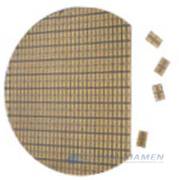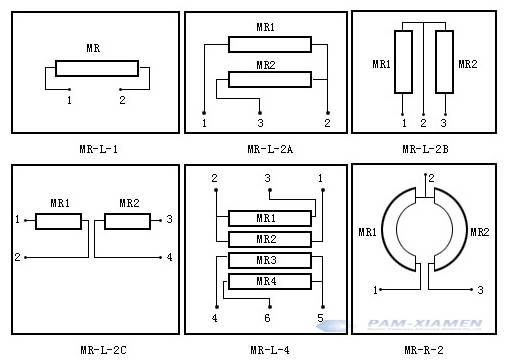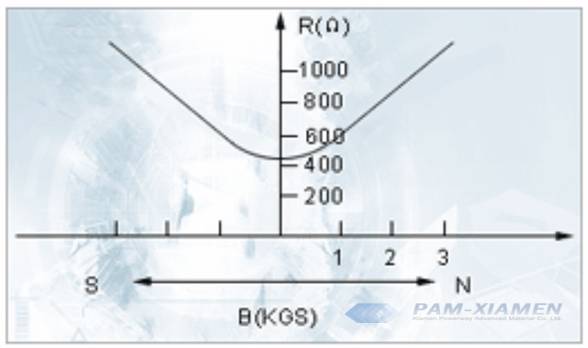Indium antimonide (InSb) thin film magnetoresistor, which is the core sensitive element of magnetoresistance (MR) sensor, is provided from PAM-XIAMEN with characteristics of non-contact measurement, small size, high reliability, high signal-to-noise ratio and wide frequency response (0-100kHz). InSb magnetoresistance is a new type of sensitive element made by using the magnetoresistance effect of InSb film. It can use a magnetic field as a medium to convert various non-electrical quantities (such as various displacements and speeds) into changes in resistance values, so as to measure or control non-electrical quantities. Since this conversion is carried out in a non-contact situation, the magnetoresistance sensor has the characteristics of high reliability, small size and light weight to make various sensors with it. This kind of magnetic sensitive device has a wide range of uses in industry and many scientific and technological fields. The existing magnetoresistance of PAM-XIAMEN are as follows:

1. Specifications of InSb Magnetoresistor
| Type | Size | Resistance | Sensitivity | Max. working current | Asymmetry | Operation Temperature |
| PAM-L-1 | 3.8×1.8 mm | 1×(100~2000) ohm | >2.0 | < 15 mA | – | -20~80 ℃ |
| PAM-L-2A | 4.5×3.5 mm | 2×(300~3000) ohm | >2.0 | < 15 mA | <10% | -20~80 ℃ |
| PAM-L-2B | 3.0×2.5 mm | 2×(300~3000) ohm | >2.0 | < 15 mA | <10% | -20~80 ℃ |
| PAM-L-2C | 7.6×1.8 mm | 2×(300~3000) ohm | > 2.0 | < 15 mA | <10% | -20~80 ℃ |
| PAM-R-2 | 5.0×4.0 mm | 2×(800~3000) ohm | >2.0 | < 15 mA | < 10% | -20~80 ℃ |
| PAM-L-4 | 4.6×4.0 mm | 4×(300~3000) ohm | >2.0 | < 15 mA | < 10% | -20~80 ℃ |
Magnetoresistive structure:

Mark: The production of InSb thin film magnetoresistor adopts advanced thin-film production and planar photoetching technology, and its pattern, size, and resistance can be flexibly designed according to needs.
There are three main parameters of magneto-resistive sensor:
- Magnetoresistance ratio: it refers to the ratio of the magnetoresistor resistance value to the resistance value under zero magnetic induction under specified magnetic induction intensity.
- Magnetoresistive coefficient: it refers to the ratio of the resistance value of a magnetic sensor to its nominal resistance value under certain magnetic induction intensity.
- Magnetoresistive sensitivity: it refers to the relative variation rate of the resistance value of a magnetoresistivity field sensor with the magnetic flux density under a specified magnetic flux density.
2. Magnetoresistance Sensor Working Principle
The magnetoresistive sensor fabricated on InSb thin film is often an ideal solution for high-speed measurement, angle control, position control, signal tracking, etc. Its resistance R changes with the change of the magnetic flux density B passing through it perpendicularly: when B<0.1T , R∝; when B>0.1T, R∝B; when B=0.3T>2.0, as shown in the figure below.

Using this feature, it is convenient to use the magnetic field as the medium to convert non-electricity (such as displacement, position, speed, angular displacement, pressure, acceleration, etc.) into electric energy without contact, so as to measure and control the non-electricity.
3. Magneto-resistace Effect in InSb Thin Film
InSb material is a typical compound semiconductor material. Compared with silicon, germanium and gallium arsenide, it has a significant magnetoresistance effect. Therefore, magnetoresistace sensors use InSb materials to make the magnetoresistance effect of semiconductor materials, including physical magnetoresistance effect and geometric magnetoresistance effect. The physical magnetoresistance effect is also called magnetoresistance effect. In a rectangular semiconductor chip, when a current flows along the length direction, if a magnetic field is applied in the thickness direction perpendicular to the current, the resistivity increases in the length direction of the SMR chip. This phenomenon is called physical magnetoresistive effect or magnetoresistive effect.
4. Magnetoresistance Sensor Applications
As a MR sensor, the working principles of various magnetic resistance element sensors that use magnetoresistor as the core element are the same, but the types are different according to the purpose and structure. Therefore, it can be used in magnetic sensor, which is for the instrument for measuring the residual magnetism of constant magnetic field and alternating magnetic field or electrical machinery, and navigation equipment of navigation and aviation. In addition, the magnetoresistance sensor can be for speed sensor, angular displacement sensor, and ferromagnetic sensor. The combination of magnetoresistor and electronic components can form AC-DC converter, frequency multiplier, modulator and oscillator.
More about the magnetoresistance sensor, please read: https://www.powerwaywafer.com/magnetoresistive-sensor.html
For more information, please contact us email at victorchan@powerwaywafer.com and powerwaymaterial@gmail.com.

